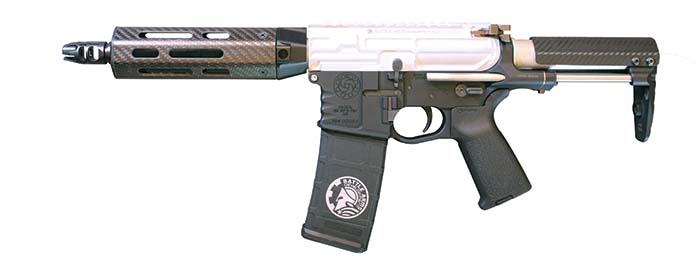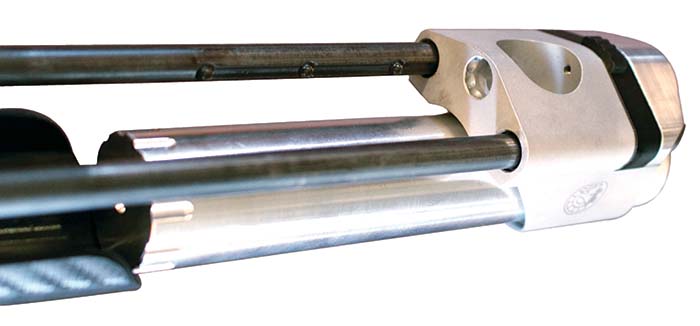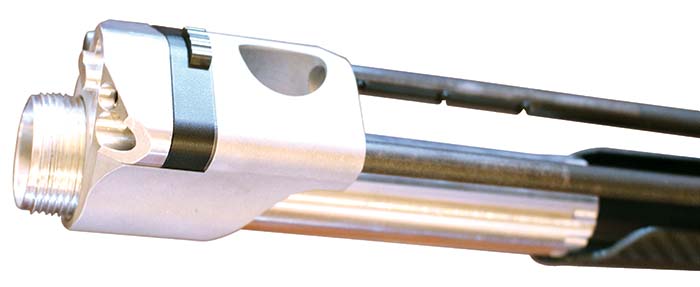An assembled prototype fitted with a 7-inch barrel. This PDW is so compact and balanced; the magazine is at the physical center of the gun. Handling and operating a weapon of this level can only be described as instinctive.
By David Lake
By now, Battle Arms Development should be on your radar and in your gun-related vocabulary. If you’re not familiar, then take note right now, Battle Arms Development (BAD) is one of the most forward thinking and capable manufacturers in America’s gun market today. Battle Arms always seems to bring new and improved items to market without much ado – they don’t celebrate every advance in function or ergonomics or performance and they don’t ever seem content to rest on their past achievements; they hold claim on many “firsts” and “bests” in the industry. BAD just continues to hand us really good products on a regular basis and their products never seem to disappoint.
BAD’s latest groundbreaking ideas are focused on the PDW (Personal Defensive Weapon). The PDW, by basic definition, is a carbine but made lighter, smaller, more adaptable and more capable than a standard rifle or carbine. The PDWs from different companies all seem to boast varied advantages. Some are indeed very small in their collapsed state; maybe only slightly larger than a pistol. Some feature calibers that are better suited to short barrels to optimize efficiency and power from a compact weapon. Some PDWs are feather-light and might maintain more common dimension and caliber and capability, but come at a significant weight savings over a typical battle-rifle. Whatever the genesis behind any particular PDW offering, they all seem to come at an inevitable compromise. Something is always given up in order to fulfill the requirements of the end user or target market: be that military, law enforcement, private security, or even the discerning consumer.
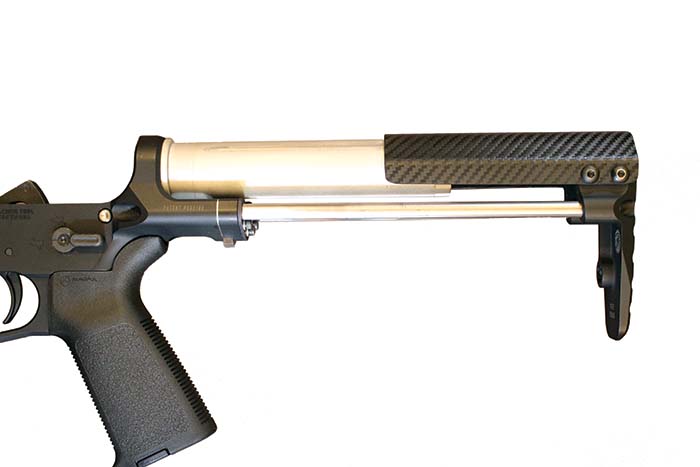
The BAD PDW extended. Note the full comb surface available for head placement. 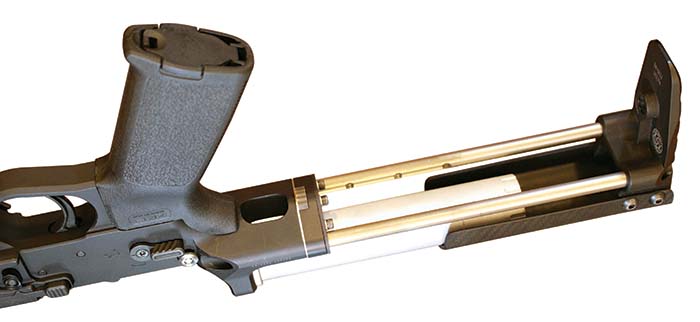
Note the efficiency in the design. This stock does not appear to be an afterthought. The lines are smooth, refined, and are very well thought out.
Now for some broad and general assertions: The AR-15 is the most widely used small arm (rifle or carbine) by America’s professionals and hobby shooters. Every agency and department has the AR-15. Every soldier and police-officer knows how to use the AR-15. Every citizen that would call himself an enthusiast has at least one AR-15. And every respectable armorer or gunsmith knows this rifle’s function and nuance inside and out. These are irrefutable arguments in favor of the AR-15. Any astute maker of small arms would be unwise to try at changing this trend. Yet, in the race to develop and exploit the growing demand for the PDW, many small arms firms choose to build their PDWs on a new and unfamiliar platform or utilize unproven technology or materials or even introduce new obscure calibers. These specialized calibers can range from the totally ineffective to the economically impossible. Some PDWs utilize pistol calibers, which are just pistols with a buttstock (not a demonstrable improvement). Some PDWs only wear the name as it is assigned and feature none of the qualifying criteria to be considered a proper PDW. Some are even heavier than the basic battle rifle upon which they’re based. The PDW should be an appropriate replacement for both carbine and sidearm without much compromise to the strengths of either. This asks much in the way of power and accuracy. This also demands that the weapon be as light and compact as possible, that the operation is fast and familiar and the construction is rugged and strong. A PDW in the hands of agency or security personnel may never be called upon to fulfill its lethal role. It may live its life and do its duty in total concealment under a vest or coat and must execute this role without becoming an impediment to the agent’s mobility and comfort. But if and when the PDW is taken to task, that weapon must become a decisive and crushing force.
If you have ever tried to decide between the capability of a carbine and the convenience of a sidearm, the PDW solves the problem.
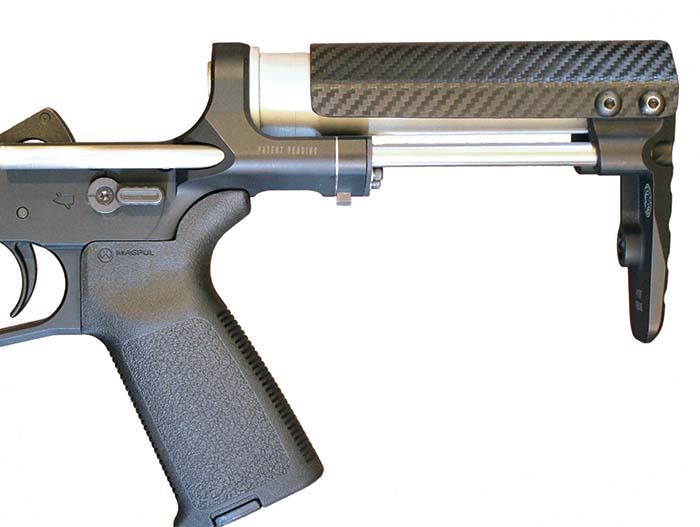
We can believe that when Battle Arms Development steps up to a challenge, they will succeed as the images seen in this article well demonstrate: this is how BAD does the Personal Defensive Weapon. The basic AR-15 has been abbreviated to make it light, compact and concealable while the manual of arms of the ubiquitous AR is maintained. Parts interchangeability and serviceability remains common. Diagnosis and repair of malfunctions can come right from the old manuals. BAD has made improvements wherever possible, yet has not hobbled or otherwise handicapped the AR-15. The PDW presented here represents a collaboration between Battle Arms Development and Cross Machine. The lines that would divide concept, engineering and execution have been blurred over the many months of design, revision and prototyping. Suffice to say, Battle Arms and Cross Machine have been synergistic partners in this project. Herein, we will not discuss the specifics of the upper half, nor the caliber of the BAD PDW. It will be enough to recognize that the upper is short and powerful. The lower and the stock are on parade here today.
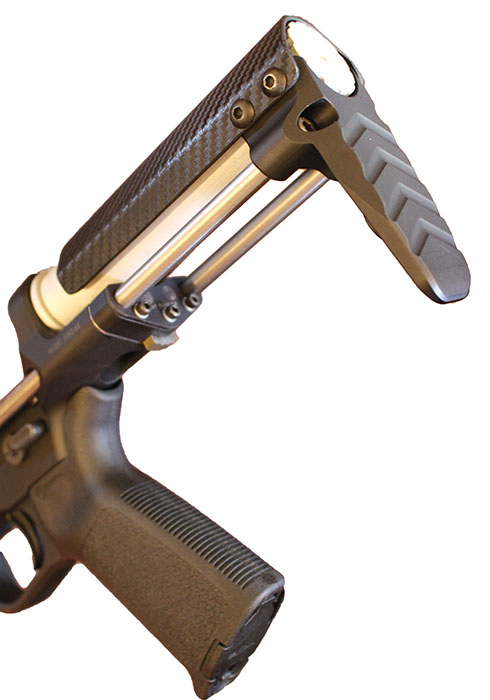
At first glance, the obvious “new” on this rifle is the stock’s design. It appears similar to the other PDW style stocks that are becoming increasingly common but, be assured; the only similarity is the purpose of that stock. The design of other PDWs tends to leave a gap under the users cheek when the stock is deployed. These also tend to require a special bolt group that either uses an integral buffer, or a buffer configuration that prevents normal service and disassembly of the rifle. The BAD PDW allows for a solid and proper cheek weld as it features an integral comb of molded textile carbon fiber that bridges that gap. The BAD PDW does require its own unique buffer; but this buffer interfaces with any standard AR-15 or M16 style bolt carrier, and does not alter normal function or operation. The tool steel shafts actually ride on ball bearings and Teflon, so the stock moves and feels like it is, well, on ball bearings and Teflon. And totally new to the market is that this PDW stock is actually part of the receiver. The receiver is created with the stock’s mounting structure machined right in. This saves weight, makes for a stronger and more compact design, and ultimately saves on cost. This is truly unique in the market.
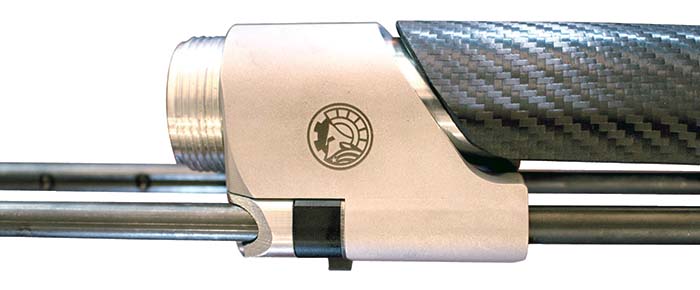
To cater to the needs of the accessory market, BAD has also created an add-on PDW stock with all the advancements and beneficial features of the PDW receiver, but the stock can be attached to any AR-15 lower receiver. The add-on PDW stock assembly is, however, slightly heavier and larger than the integral unit. Both stocks, when collapsed, are the same compact length of 6 inches from the buffer’s face and both use the same specially designed buffer. When fully extended, the add-on stock is 10 inches long and the integral PDW lower will extend to 9.5 inches. The add-on stock, when joined to a receiver, weighs a little over 3 ounces more than the integral receiver.
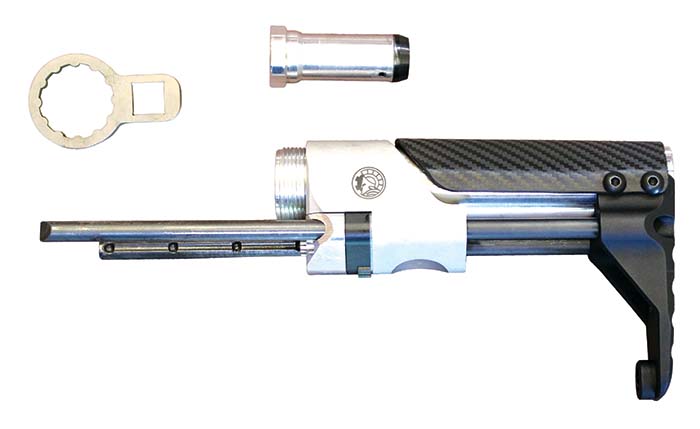
The fit and finish of both units is perfect. The type 3 hardcoat anodizing is a durable and attractive protective finish. The rods are hardened tool steel that rides in Teflon bushings and are locked into any of 5 positions by steel ball bearings. The stock, when moving, encounters very solid and satisfying “clicks” as the ball bearings snap positively into the detent locations. The hardened locking button is cut on a wire-EDM machine. This locking button can be actuated by the knuckle at the base of the thumb of the “gun hand” while the shooter’s free hand can reach across and position the stock where it may be required. The butt plate is larger and smoother than most other DW stock applications. The most impressive feature of the BAD PDW and accessory stock is both are as solid as any fixed stock on the market. There is no perceptible wobble, shake or rattle in the system. They are expertly designed and crafted with an artist’s pride. Suffice to say that it is an over-achieving piece of engineering and is peerless in execution. Battle Arms assures us that the price of these units will be very competitive with the current offerings for items claiming similar capabilities.
Here at Small Arms Review, we know and recognize the trends in small arms design and development. We have seen them all come and go. We have seen established companies flounder as they refuse to keep up with the times. We have seen promising new startups fail only by their own misplaced enthusiasm. We can authoritatively say that the future will demand unconventional design and the use of advanced materials and a degree of risk taking in small arms design. The consumer is becoming increasingly well-informed and demands that his new gun be something special – and genuinely new. Numbered are the days of cookie cutters and rubber stamps churning out the basic black rifle in a new box with a new name. The new consumer won’t be fooled by yet another “AR.” Battle Arms Development does it right.
| This article first appeared in Small Arms Review V19N8 (October 2015) |



